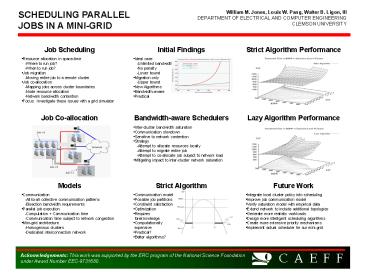Job Scheduling - PowerPoint PPT Presentation
1 / 1
Title:
Job Scheduling
Description:
Acknowledgements: This work was supported by the ERC program of the National ... Attempt to allocate resources locally -Attempt to migrate entire job -Attempt ... – PowerPoint PPT presentation
Number of Views:23
Avg rating:3.0/5.0
Title: Job Scheduling
1
Job Scheduling
Job Co-allocation
Models
Initial Findings
Bandwidth-aware Schedulers
Strict Algorithm
Strict Algorithm Performance
Lazy Algorithm Performance
Future Work
SCHEDULING PARALLEL JOBS IN A MINI-GRID
William M. Jones, Louis W. Pang, Walter B. Ligon,
III DEPARTMENT OF ELECTRICAL AND COMPUTER
ENGINEERING CLEMSON UNIVERSITY
- Resource allocation in space-time
- -Where to run job?
- -When to run job?
- Job migration
- -Moving entire job to a remote cluster
- Job co-allocation
- -Mapping jobs across cluster boundaries
- -Node resource allocation
- -Network bandwidth contention
- Focus Investigate these issues with a grid
simulator
- Ideal case
- -Unlimited bandwidth
- -No penalty
- -Lower bound
- Migration only
- -Upper bound
- New Algorithms
- Bandwidth-aware
- Practical
- Inter-cluster bandwidth saturation
- Communication slowdown
- Sensitive to network contention
- Strategy
- -Attempt to allocate resources locally
- -Attempt to migrate entire job
- -Attempt to co-allocate job subject to network
load - Mitigating impact to inter-cluster network
saturation
- Communication
- -All-to-all collective communication patterns
- -Bisection bandwidth requirements
- Parallel job execution
- -Computation Communication time
- -Communication time subject to network
congestion - Mini-grid architecture
- -Homogenous clusters
- -Dedicated interconnection network
- Communication model
- Possible job partitions
- Constraint satisfaction
- Optimization
- Requires foreknowledge
- Computationally expensive
- Practical?
- Better algorithms?
- Integrate local cluster policy into scheduling
- Improve job communication model
- Verify saturation model with empirical data
- Extend network to include additional topologies
- Generate more realistic workloads
- Design more intelligent scheduling algorithms
- Create more extensive priority mechanisms
- Implement actual scheduler for our mini-grid
Acknowledgements This work was supported by the
ERC program of the National Science Foundation
under Award Number EEC-9731680.

